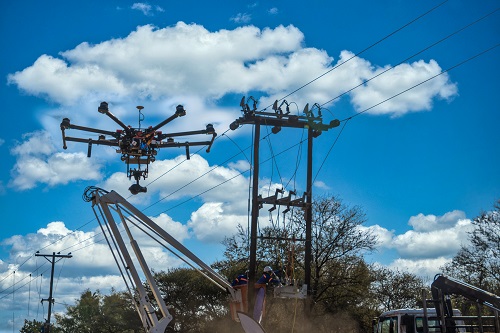 Wednesday, April 24, 2024
Wednesday, April 24, 2024  Wednesday, April 24, 2024
Wednesday, April 24, 2024 
Providing safe, affordable, reliable energy has always called for adapting to shifting market and regulatory demands. The challenge has only increased as emerging technologies reshape the utility industry. And the pace of transformation is accelerating.
So how can utilities take advantage of these trends — finding new ways to improve reliability, efficiency, safety and security throughout their operations?
“Utilities have to adjust to the new normal we live in,” says Stefan Wolf, utilities industry vice president at SAP. “It’s about being able to analyze that data and predict future events.”
“Utilities no longer have a choice but to embrace technology to foster innovation and change,” says Brad Williams, vice president of industry strategy at Oracle Utilities. “Machine learning and artificial intelligence (AI) can supercharge the efficiency and resilience of the core business. Other technologies can lead to entirely new value-added services and business models.”
THE CONVERGENCE OF DATA AND ANALYTICS
Real-time data analytics offers incredible potential for the utility sector — from reducing outages and maintenance costs to improving demand response.
“It’s coming together at the right time,” say Wolf. “Decisions have to be pushed toward the frontline to meet the speed of business. Executives need data and insights they can rely on. The convergence of these technologies allows utilities to put decision automation, control and oversight into the hands of the people who can use it.”
“By applying sensors, AI and machine learning to their systems, utilities can be more prepared and resilient,” says Williams. “Take a situation such as severe weather. Using historical weather patterns to predict the impact on the grid, utilities can have crews and equipment ready to restore power and minimize outages.”
Additional data collection points include smart meters, IoT device analytics, and implementing cloud-based solutions. That way, leaders can see, for example, if tools are being implemented correctly, and if everyone is working from the same data.
SUPPORTING THE RENEWABLE TRANSITION
As the energy sector shifts to solar, wind and other renewable sources, forward-looking utilities are using new technologies to ease the transition.
“The pandemic-related disruptions have underscored the industry’s need to focus on key areas which ensure grid stability and load shifting,” says Williams. “With distribution energy resources (DER) and smart home devices playing a bigger role, utilities are also looking for new opportunities to leverage data to create innovative customer connections.”
“Electric vehicles (EV) are one of the best examples of the critical role customers can play in balancing the grid,” says Williams. “If EV growth continues at its present rate, utilities will grapple with peak load impacts at the grid edge — particularly on hot days — when people come home from work and plug in their vehicles. A single EV can double the demand of a typical home.”
EVs and batteries/microgrids offer utilities opportunities to work more directly with the end user, especially by encouraging use during optimal times.
NEW TOOLS TO SECURE THE GRID
The more distributed the grid gets, the more entry points exist for cybersecurity threats.
“Technology has enabled a greater amount of interconnectivity with things like IoT and edge devices to manage operations,” says Wolf. “This opens more ways for potential bad actors to access systems. Tools such as advanced analytics can test data streams — both from the distribution grid and the communication network — for signs of intrusion or manipulation. This helps utilities see potential weak points and address them in real time.”
“Make no mistake: utilities take cybersecurity seriously,” says Williams. “They’re continually rethinking how they can fortify the grid. Just recently, several utilities formed an alliance with key financial service institutions to see what they can learn from each other. At some point, however, having autonomous systems, AI and machine learning in place will be key to combatting cybersecurity threats as they occur.”
IMPROVING TRAINING AND SAFETY
Finding, training and retaining skilled workers continues to be one of the industry’s biggest challenges. Utilities are applying new technologies to give employees the training they need and improve jobsite safety.
“Virtual reality (VR) and augmented reality (AR) hold clear benefits when it comes to training and safety,” says Wolf. “They allow employees to prepare for hazardous jobs and hone their skills without putting themselves at physical risk.”
“VR and AR take the guesswork out of certain situations,” says Williams. “This can dramatically lower training requirements. Take a broken transformer. Previously, a staff member would have needed to be extremely familiar with that equipment to successfully fix it quickly. Now technology can give newer personnel a guided tour on how to get to the damaged component and replace it.”
“Drones can be a powerful tool for utility companies, as well,” says Wolf. “Inspecting and maintaining powerlines and other distributed utilities equipment is an inherently dangerous task, even more so in challenging terrain. Drones are ideally suited for such environments. They’re essentially IoT devices sending back data to provide insights into critical physical infrastructure.”
Colby Ryan of Exelon Clearsight adds their use of drones to replace walking inspections has dramatically improved both inspector safety as well as inspection effectiveness, especially given the new ability to see the tops of power lines in detail.
About The Utility Expo
The Utility Expo is the largest event for utility professionals and construction contractors seeking comprehensive insights into the latest industry technologies, innovations and trends. The biennial trade show, known for equipment test drives and interactive product demonstrations, takes place in Louisville, Ky. The next event will be September 28-30, 2021.
About the Association of Equipment Manufacturers (AEM)
AEM is the North America-based international trade group representing off-road equipment manufacturers and suppliers with more than 1,000 companies and more than 200 product lines in the agriculture and construction-related industry sectors worldwide. The equipment manufacturing industry in the United States supports 2.8 million jobs and contributes roughly $288 billion to the economy every year.